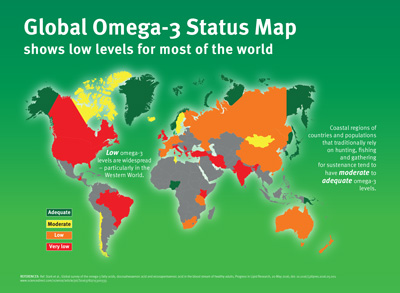Omega-3 status map highlights possible public health issue
- Like
- Digg
- Del
- Tumblr
- VKontakte
- Buffer
- Love This
- Odnoklassniki
- Meneame
- Blogger
- Amazon
- Yahoo Mail
- Gmail
- AOL
- Newsvine
- HackerNews
- Evernote
- MySpace
- Mail.ru
- Viadeo
- Line
- Comments
- Yummly
- SMS
- Viber
- Telegram
- Subscribe
- Skype
- Facebook Messenger
- Kakao
- LiveJournal
- Yammer
- Edgar
- Fintel
- Mix
- Instapaper
- Copy Link
Posted: 20 June 2016 | Victoria White, Digital Content Producer | No comments yet
A new study indicates that adults in most regions of the world have a low to very low status of omega-3 polyunsaturated fatty acids (PUFAs)…


DSM Nutritional Products have contributed to a new study which indicates that adults in most regions of the world have a low to very low status of omega-3 polyunsaturated fatty acids (PUFAs), particularly eicosapentaenoic acid (EPA) and docosahexaenoic acid (DHA).
Low levels of PUFAs in the bloodstream are associated with a high risk of chronic diseases such as cardiovascular disease, cancer and diabetes. This global map is the first of its kind. Such a detailed global overview of PUFA status has never before been available.
Researchers reviewed 298 studies to create a global map showing the levels of EPA and DHA in the bloodstreams of healthy adults across the world, identifying which regions are more at risk of chronic illness. Regions classified as having very low EPA and DHA blood levels (<4%) included North, South and Central America, Central and Southern Europe, the Middle East, Southeast Asia and Africa. The Sea of Japan, Scandinavia and regions with indigenous populations or populations who have not adopted Westernised food habits were classified as having high status of EPA and DHA (>8%).
Developing guidelines for omega-3 intake
Commenting on the research, Dr Manfred Eggersdorfer, Senior Vice President, Nutrition Science and Advocacy at DSM and Professor of Healthy Ageing at the University Medical Centre Groningen, said: “As stated by the World Health Organisation, chronic disease is estimated to be the cause of death of approximately 38 million people worldwide every year. PUFAs, and EPA and DHA in particular, have long been associated with decreased risk of cardiovascular mortality and cognitive decline. The conclusions of this paper highlight that a significant proportion of the population are at increased risk of chronic disease due to low omega-3 PUFA status.”
Dr Norman Salem, Jr., Senior Science Fellow, Nutritional Lipids at DSM, elaborated: “In the past we have been limited by the absence of the comprehensive analysis of data that is now available to us. By developing the global map, we can better understand the current levels of omega-3 PUFAs in the blood of healthy adults worldwide. The findings can then be used when developing both national and global guidelines regarding omega-3 intake. New recommendations will not only give the general population guidance on adequate PUFA intake, but also highlight the risks of low levels of bloodstream EPA and DHA.”









